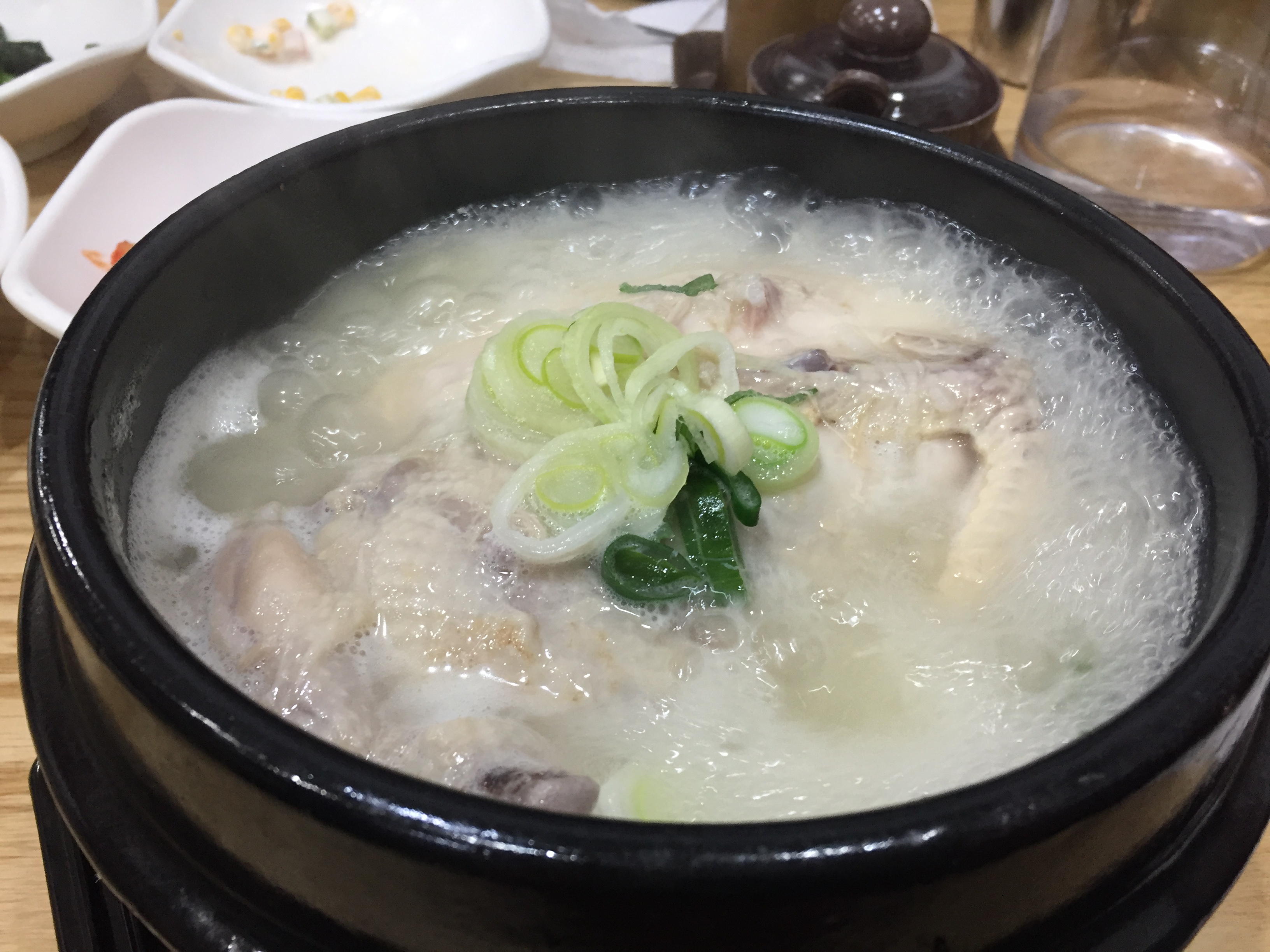Samgye-tang on:
[Wikipedia]
[Google]
[Amazon]
''Samgye-tang'' (), or " ginseng chicken soup"
* is a '' tang'' (Korean soup) that consists primarily of a whole young 
Nutritious foods of summer and wine
Maekyung, 2009-07-07.Retrieved 2010-07-06.
Samgye-tang.jpg, ''Samgye-tang'' (closeup)
Image:Korean soup-Samgyetang-13.jpg, ''Samgyetang''
Image:Korean soup-Samgyetang-12.jpg, ''Samgyetang''
Image:Korean soup-Samgyetang-06.jpg, ''Samgyetang'' with '' kimchi'' and '' insam-ju'' (ginseng wine)
Image:Korean chicken soup-Ogolgyetang-01.jpg, '' Ogolgye samgyetang''
chicken
The chicken (''Gallus gallus domesticus'') is a domesticated subspecies of the red junglefowl (''Gallus gallus''), originally native to Southeast Asia. It was first domesticated around 8,000 years ago and is now one of the most common and w ...
( ''poussin'') or quail filled with garlic, rice, jujube and ginseng
Ginseng () is the root of plants in the genus ''Panax'', such as South China ginseng (''Panax notoginseng, P. notoginseng''), Korean ginseng (''Panax ginseng, P. ginseng''), and American ginseng (''American ginseng, P. quinquefol ...
. It is traditionally considered to be a health food. ''Samgye-tang'' is a representative summer health food. Soup made with chicken that is slightly larger than the chick is called ''yeonggye baeksuk'', and the chicken is divided into half is called ''banggye-tang''.

History
During theJoseon
Joseon ( ; ; also romanized as ''Chosun''), officially Great Joseon (), was a dynastic kingdom of Korea that existed for 505 years. It was founded by Taejo of Joseon in July 1392 and replaced by the Korean Empire in October 1897. The kingdom w ...
period (1392–1897), people enjoyed the numerous chicken soup dishes that were similar to ''samgye-tang'', including ''yeongye-tang'', ''chonggye-tang'', and ''hwanggye-tang''. While it was the custom to make a soup with young chicken and serve it to elders during the summer days, the chicken boiled with milkvetch roots and its broth were served to the sick queen during King Injo's reign. However, the description of the dish that most closely resembles today's form of ''samgye-tang'' can be found in ''Joseon yorijaebeop'' (), the cookbook. Bang Sin-yeong, a professor of Ewha Womans University
Ewha Womans University () is a private women's research university in Seoul, South Korea. It was originally founded as Ewha Haktang on May 31, 1886, by missionary Mary F. Scranton. Currently, Ewha Womans University is one of the world's largest f ...
, wrote in 1917 to compile the information on how to make various traditional dishes of Joseon. In the book, it is described that ''dakguk'' (), or chicken soup, is made by gutting a chicken and stuffing the inside with three spoons of glutinous rice and one spoon of ginseng powder, followed by tying up the opening and boiling the chicken with ten bowls of water. During the Japanese colonial era, the Japanese officials who investigated the cultures of former Joseon noted that rich families boiled the chicken stuffed with ginseng and used the broth as medicine in summer.
The dish began to be commercially sold at restaurants around 1940s and under the name ''gyesam-tang'' () in 1950s, which meant chicken ginseng soup. With the supplying of modern refrigerator
A refrigerator, commonly shortened to fridge, is a commercial and home appliance consisting of a thermal insulation, thermally insulated compartment and a heat pump (mechanical, electronic or chemical) that transfers heat from its inside to ...
s in Korea, it became possible to preserve a ginseng as whole instead of powder. Thus, since 1960s, it became more common to stuff the chicken with a whole piece of ginseng instead of powder, reaching today's form of the dish. To emphasize the medicinal effects of the ginseng in the soup, many people since then have started calling the dish ''samgye-tang'' (ginseng chicken soup) instead of ''gyesam-tang'' (chicken ginseng soup).
Custom
It is the custom in Korea to eat ''samgye-tang'' during hotsummer
Summer or summertime is the hottest and brightest of the four temperate seasons, occurring after spring and before autumn. At or centred on the summer solstice, daylight hours are the longest and darkness hours are the shortest, with day ...
days in order to replenish the nutrients that were lost through the sweating and physical activities. It is especially popular to eat this chicken soup on ''sambok'' () days, which are three distinct days of the lunar calendar—''chobok'' (), ''jungbok'' (), and ''malbok'' ()—commonly among the hottest and most sultry summer days in Korea.
Some specialty restaurants in South Korea serve only ''samgyetang'', having gained local popularity through their special recipes for the dish, which are often kept as secrets. The dish is sometimes accompanied by a small complimentary bottle of '' insam-ju'' (ginseng wine) in certain restaurants.Maekyung, 2009-07-07.Retrieved 2010-07-06.
Gallery
See also
* '' Baeksuk'' * '' Dak-bokkeum-tang'' * '' Ori-tang'' * List of chicken dishes * List of soups *List of Korean dishes
Below is a list of dishes found in Korean cuisine.
Rice dishes
* ''Bibimbap'' (, 'mixed rice'): rice topped with seasoned vegetables such as spinach, Edible mushroom, mushrooms, sea tangle, carrots, bean sprouts, and served with a dollop of '' ...
References
External links
* * {{cite news, url=http://www.idomin.com/news/articleView.html?idxno=225619 , title=Samgyetang Story 2 (삼계탕 이야기 (하)) , publisher=idomin.com , language=ko , author=Kim Yeong-bok (김영복) / Yeo Gyeong-mo (여경모) , date=2007-07-26 Korean chicken dishes Korean soups and stews Chicken soups